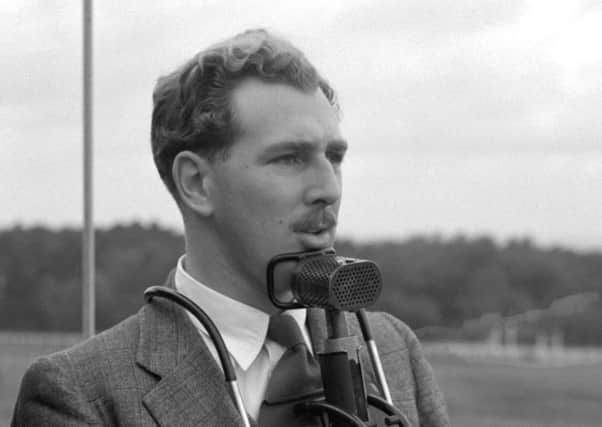Obituary: Peter Dimmock, CBE CVO, broadcaster


With his trademark neatly trimmed moustache, Peter Dimmock was arguably the most famous and most popular face on British screens during the early days of television in the post-war years and through the 1950s, 60s and 70s. A true broadcasting pioneer, he was the first presenter of the live Saturday sports programme Grandstand, first host of the Sports Personality of the Year awards and an early presenter of the old Come Dancing – in black and white – long before it was reincarnated as Strictly.
As the head of the BBC’s fledgling Outside Broadcasts division, Dimmock led the live coverage of the Queen’s Coronation on 2 June, 1953, after personally persuading the new monarch to allow cameras into Westminster Abbey.
Advertisement
Hide AdAdvertisement
Hide AdMore than 20 million people, 40 per cent of the British population, watched the ceremony, most of them outside their homes in places where TV screens were shared in public places, even in streets. It was the first time more British people watched a major event than listened to it on radio.
Within a year of the broadcast, TV licences doubled.
“Even (Prime Minister) Winston Churchill was against broadcasting it live but we used every trick in the book because people deserved to see the Coronation,” Dimmock recalled. “There was a rule that no camera could be closer than 30 feet from the Queen. I got a girl to walk down the aisle as though she was the Queen, but used a two-inch lens – the widest there was – and she looked a mile away. They (Buckingham Palace) were happy with that, but what they didn’t know was that I was going to use a 12-inch lens that would give the best close-up of the Queen that there had ever been.”
Again using his gentlemanly charm, he persuaded the owner of Aintree racecourse, Mirabel Topham, to give up years of reluctance and allow the BBC to televise the Grand National in 1960, coverage of which he personally fronted.
A horse-lover and racehorse-owner himself, it was Dimmock who got a job at the BBC for a young racing journalist called Peter O’Sullevan, who would become known as “the Voice of Racing” and died in July this year. Dimmock himself owned such decent racehorses as Leigh Crofter, a multiple-winning sprinter in the 1990s, trained by Peter Cundell at Newbury.
It was Dimmock, in 1958, who, along with producer Paul Fox, launched Grandstand with the idea of linking live outside broadcasts with football, racing and other results as they happened – now a template for other programmes such as Sky TV’s fast-moving Soccer Saturday. Dimmock initially introduced Grandstand before handing over to a protegé, David Coleman, who would in turn give way to Frank Bough, Desmond Lynam and Steve Rider. It ran for almost 50 years until 2007.
“The most important thing of all were the full-time results on the teleprinter with everyone sitting at home with their coupons, seeing the results as they came up,” Dimmock recalled years later.
Peter Harold Dimmock was born in London on in 1920 and educated at Dulwich College, an independent public school on Dulwich Common, south-east-London.
His father Frederick was head of the Equipment Department at the BBC, itself a pioneer in fledgling TV broadcasting.
Advertisement
Hide AdAdvertisement
Hide AdAfter the outbreak of war, aged 18, Peter signed up for the Territorial Army before transferring in 1941 to the Royal Air Force where he served as a pilot and flying instructor before being taken on as a staff officer the Air Ministry.
He never revealed whether he had been involved in air combat but he would certainly have played an important role in Britain’s anti-Luftwaffe defences.
After the war, he got a job as a horse-racing correspondent for the Press Association, Britain’s national news agency, before joining the Outside Broadcasts department of the BBC’s infant TV service at Alexandra Palace.
Still only 27, he produced and helped mastermind BBC TV coverage of the 1948 London Olympics, supervising coverage at Wembley Stadium, the Empire Pool and other venues. The following year, he led the first TV coverage of the Oxford-Cambridge Boat Race.
In 1954, he became presenter of the new Sportsview programme, which soon became Sportsnight and led to him hosting the first BBC Sports Personality of the Year awards.
He also produced the 1960 wedding of Princess Margaret and Antony Armstrong Jones and the moving 1965 funeral of wartime hero Churchill.
He recalled that the innovative Sportsview owed much of its success to the fact, on the day of its opening edition, its cameras were there to capture Roger Bannister breaking the four-minute-mile barrier in Oxford.
“We hired a racing driver to get Roger back to the studio before the end of the programme. Roger said it was the most horrific car journey he had ever experienced, but we got him there and I interviewed him. That kicked the programme off to a good start.”
Advertisement
Hide AdAdvertisement
Hide AdDimmock left the BBC in 1978 and held several senior positions for American TV networks. In 1991, he became chairman of Zenith Entertainment, which brought us Inspector Morse, before retiring in 2000 just short of his 80th birthday.
The Queen made him a Commander of the British Empire and Commander of the Royal Victorian Order (CVO).
He married well-known TV presenter Mary Freya “Polly” Elwes in 1960 and they had three children, Amanda, Christina and Freya. Polly died in 1987. In 1990, Dimmock married Christabel Rosamund Bagge-Scott, daughter of Sir John Bagge, 6th Baronet of Stradsett Hall, Norfolk.
The couple lived in Warback, Norfolk, until fire ravaged their home in 2009. They moved to Upton Grey, Basingstoke, Hampshire. He is survived by his wife and his three daughters from the marriage to Elwes.